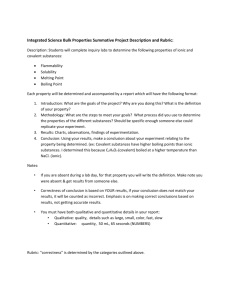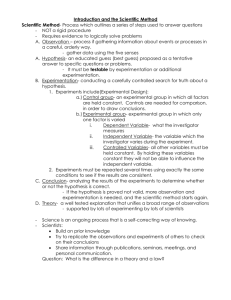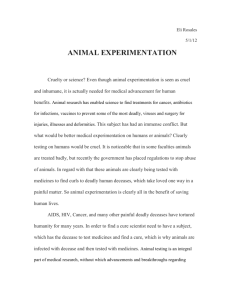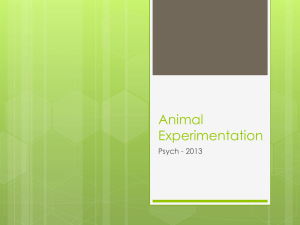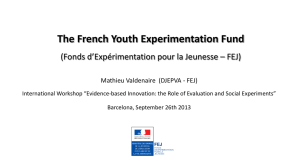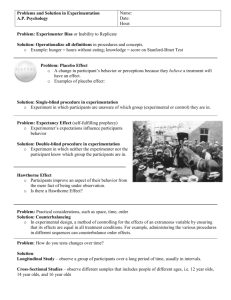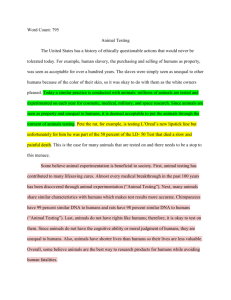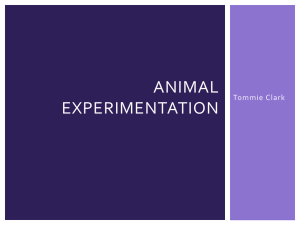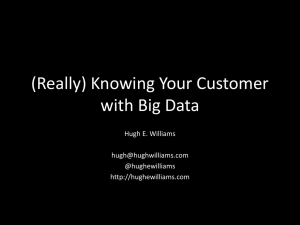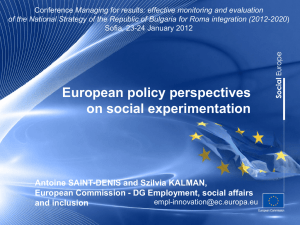Experimentation Lexicon V1.1
advertisement
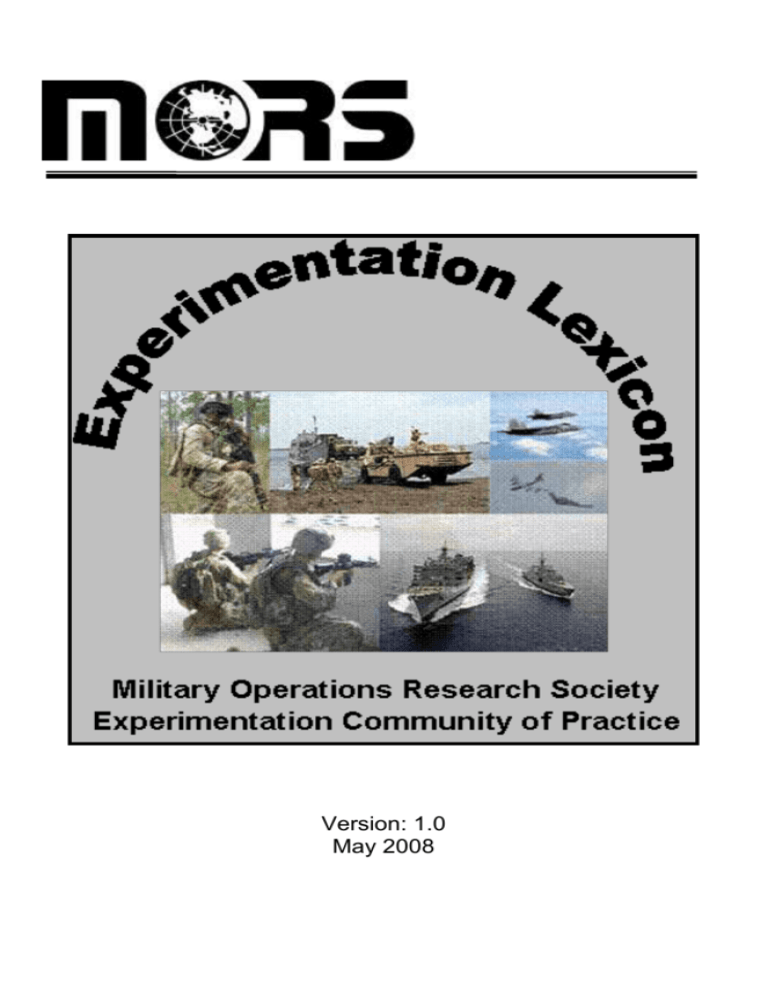
Version: 1.0 May 2008 Purpose: This booklet is intended to provide a common experimentation lexicon (“In linguistics, the lexicon of a language is its vocabulary, including its words and expressions.”) for military analysts. This lexicon standardizes terminology for use in military experimentation. It does not intend to rewrite doctrine or any Service’s terminology—instead it is designed to serve as a ready reference in support of experimentation. Sources: All documents used in the preparation of this paper are unclassified. In addition to formal publications, such as Army Pamphlet 5-5 (Guidance for Army Study Sponsors, et al), numerous informal source documents provided valuable input (for example, the TRADOC Analysis Center’s Analysis 101 briefing, JFCOM J-9’s Analyst Department – Lexicon briefing, and the US Air Force Analytic Framework for Experimentation, T&E and Acquisition briefing). Organization: This booklet is organized in two sections. In section one are the key terms with corresponding definitions and descriptions. In section two are relationship models that may aid the military analyst’s understanding of the interactions and intent of key experimentation terms. Changes: This is the original working draft version of the lexicon, no changes have been made. As a living document, the MORS Experimentation COP invites corrections, additions, and edits that will enhance a common understanding of the terms and expressions used in military experimentation. Recommended changes may be sent to either Kirk Michealson [kirk.a.michealson@lmco.com] or Steven Strukel [strukel_steven@bah.com]. Section One: Terms & Definitions Term: analysis plan Definition: Interim experiment planning document that continues the problem decomposition process from the study plan's EEA level into measures of merit. Documents anticipated methodologies for data collection and analysis. Identifies constraints, limitations, and assumptions associated with the experiment. Discussion: Defines the... Problem to be analyzed Constraints, assumptions, EEA, Measures of Merit (MOM) Alternatives to be analyzed, criteria & methods for evaluation Scenarios and input data requirements Model and data validation Relationship Model: Experimentation Planning Term: assumption Definition: 1. An educated supposition in an experiment to replace facts that are not in evidence but are important to the successful completion of a study (contrasted to presumption) 2. Statement related to the study that is taken as true in the absence of facts, often to accommodate a limitation (inclusive of presumptions) Discussion: For the purposes of experimentation, an assumption is usually applied to the mathematical/statistical underpinnings of an experiment, or with regards to the experiment conditions (scenario, available forces, operating environment, etc.). Some statistical analysis requires certain assumptions about the data. An assumption is a proposition that is taken for granted, in other words, that is treated for the sake of a given discussion as if it were known to be true. After data collection, most statistical analysis assumptions can be empirically assessed. Not all assumptions are equally important. Assumptions are often developed regards the experiment conditions to overcome limitations that would otherwise significantly impact the experiment's continuation. Term: CLA Definition: Constraints, limitations, and assumptions are a critical part of the study process. They are an important tool in communicating with a study sponsor and for establishing the bounds of a study. Discussion: There are five basic tenets necessary to follow when identifying CLA: (1) identify two sets of CLA (full and key; full CLA are all those with impact on the study as identified by the analysis team, key CLA are shared with the study sponsor, allowing them the opportunity to remove or mitigate constraints); (2) develop CLA in order (constraints, then limitations, then assumptions); (3) ensure all CLA are necessary, valid, and accepted, (4) continually review and update CLA; and (5) tailor CLA to the specific audience. Adhering to these basic tenets contributes greatly to enabling a successful study and communicating the results. Term: condition Definition: A variable of the environment that affects performance of a task Discussion: Describes the environmental conditions (variables) that affect task performance. It details the when, where, why, and what materials, personnel, and equipment are required. These explain what is a given (taken to be a basis of fact –presumptions) or not given, and what variables exist which are controlled and which are uncontrolled (or uncontrollable). The conditions of an experiment address pertinent aspects of: physical environment-terrain, weather, etc military environment-friendly and enemy forces, weapons, C2, etc. civil environment-sociological, political, NGO’s, infrastructure, etc. Term: constraint Definition: A restriction imposed by the study sponsor that limits the study team’s options in conducting the study. Discussion: The sponsor’s guidance that limits the time available for the study, the resources the sponsor (or the chain of command) makes available, and the study scope often lead to constraints. The key consideration in determining if these elements of guidance constitute constraints is the impact the guidance will have on the study team’s ability to fully investigate the issues. If the time allotted is very short, there’s a good chance that the team cannot credibly or thoroughly investigate issues. If few people are made available to conduct the study, the investigation of the issues might likewise be limited. Finally, the sponsor may sometimes impose a constraint that serves to scope the effort too narrowly. Although less work might be appealing to the study team, a scope that is too narrow could severely limit the applicability of the results. For example, if a study team is working on an investment strategy for precision munitions that covers the period 2008 – 2014, but the sponsor limits the investigation to forces that will be fielded only after 2012, then the analysis results may not apply to the period before then. Term: data Definition: Raw information gleaned from monitored human behavior or simulation output Discussion: Data are objective information obtained by observation (monitoring or tabulation) or generated by a computer or automated device. These are, in their very essence, facts or pieces of information. They have no connotation or value or goodness, except for quantity and categorical (classifying) labels attached to them. Data is information out of context and therefore does not reflect any level of knowledge. Data serves as the basis for statistical and qualitative analysis. Data can serve as a basis upon which to make decisions, or it can be processed by humans (subject matter experts) or computers (model, simulations, math tools) to provide: understanding; refined information with a connotation of goodness or satisfaction; or to support comparative analysis. Data collected during an experiment can be objective (factual data) or subjective (expert opinion or observation). Relationship Model: Analysis Term: data collection management plan (DCMP) Definition: Final experiment planning document that further decomposes the measures identified in the Analysis Plan into data elements. Provides detailed guidance for the collection and management of experimentation data. Discussion: Defines the... Data collection requirements (the data elements to be collected, when, where and how they will be collected) Data reduction and quality control processes (how is the data archived & reduced) Resources for the organization and execution of plan (who does what) Relationship Model: Experimentation Planning Term: data element Definition: Data to be collected, to include: the content of the data (type, periodicity, and format), collection mechanism (automated or manual processes, timeframe, location, and method), data handling procedures, and relationship of the data to the experiment (what measures are supported by the data) Discussion: Data elements must be definable, specific and measurable. Data elements define collection responsibilities and tasks (who is collecting what, when, where, and how). Data elements are catalogued in the DCMP (or DCAP [Navy]) Relationship Model: Decomposing the Problem Term: dimensional parameters (DP) Definition: DP are focused on the properties or characteristics inherent in a C2 system Discussion: Somewhere between a data element and a measure of performance, DP define attributes such as bandwidth, data access times, cost, and size inherent in a C2 system Term: empirical Definition: Verifiable or provable by means of observation or experiment Discussion: Empirical describes results determined by experiment and observed behavior or facts; theoretical describes results that are based on guesswork or hypothesis - and pragmatic is contrasted with theoretical on the grounds that the former proceeds from what is demonstrably practical, the latter from conjecture. A central concept in science and the scientific method is that all evidence must be empirical, or empirically based, that is, dependent on evidence or consequences that are observable by the senses. Empirical is used to refer to working with hypotheses that are testable using observation or experiment. Term: end-state Definition: Ultimate conditions resulting from a course of events Discussion: The term can refer to the complete set of required conditions that defines achievement of the specified objective or individual deliverables that represent partial/complete satisfaction of the experiment objectives. The end state is an envisioned future state, event or verifiable product that illustrates satisfaction of an objective or goal. An end state should be clearly defined to facilitate its satisfaction through efforts in the experiment. Term: essential element of analysis (EEA) Definition: Decomposes experiment issues into focused questions essential to meeting an experiment's objectives Discussion: EEA delineate sub-elements of the problem for which answers must be produced. They usually require narrative answers; the quantitative output of the experiment is used with judgmental evaluations to produce meaningful answers formulated in such a manner that they give a judgmental (informed) evaluation of the critical issues in the experiment. Relationship Model: Decomposing the Problem Term: experiment Definition: The process of exploring innovative methods of operation, especially to assess their feasibility, evaluate their utility, or determine their limitations. Discussion: Experimentation knowledge differs from other types of knowledge in that it is always founded upon observation or experience. In other words, experiments are always empirical. However, measurement alone does not make an experiment. Experiments also involve establishing some level of control and also manipulating one or more factors of interest in order to establish or track cause and effect. A dictionary definition of experiment is a test made “to determine the efficacy of something previously untried,” “to examine the validity of an hypothesis,” or “to demonstrate a known truth.” These three meanings distinguish the three major roles that DoD organizations have assigned to experimentation. Term: experiment level Definition: Three category descriptor that conveys the level of resources required to conduct an experiment (Level 1 thru 3) Discussion: Level I - constructive analysis & tests of materiel Level 2 - human in the loop role players Level 3 - live/simulation events Term: experiment type Definition: There are three types of experimentation (discovery, hypothesis testing, and demonstration) that provide common understanding for the use of, and rigor of results expected from, any given experiment. Discussion: Discovery Experiments - involve the introduction of novel systems, concepts, organizational structures, etc. to a setting where their use can be observed (e.g. How is the innovation employed and does it appear to have military utility?) Hypothesis Testing Experiments - classic scientific method to build knowledge through controlled manipulation of factors thought to cause change (e.g. Does the innovation improve force effectiveness?) Demonstration Experiments - display existing knowledge, known truths are recreated (e.g. Here are the innovations and how they impact force effectiveness.) Term: experimentation plan (also experiment directive) Definition: Document from the study sponsor that details the experiment goals and objectives, schedule, and resources available. Discussion: Defines the… Overarching experiment objectives Resources for the organization and execution of the experiment Experiment schedule Desired experiment end-state Relationship Model: Experimentation Planning Term: finding Definition: 1. Increased depth to the overall understanding of a single topic or issue. 2. A conclusion reached after examination or investigation; the corroboration of an insight from multiple venues; a combination of quantitative and statistical comparisons of various cases or treatments examined, supplemented and amplified by qualitative observations and assessments Discussion: The discernment (analysis) of several observations that provides depth to the overall understanding of a topic or issue. A finding can either discover (indicating learning) or confirm the truth of (something). Findings are usually developed over a campaign of experiments to allow for varied treatments and conditions, based on multiple, corroborating insights. Relationship Model: Analysis Term: insight Definition: The synthesis of a set of observations that reveal a capability (or void), an enabler (or barrier) to that capability, and a warfighting impact Discussion: The examination (synthesis) of observations (empirical data) that provides a quantitative or qualitative judgment. This is an evaluation of learning to determine what the value it represents to a customer or the community at large. It is typically identified as an un-executable suggestion or belief that (something) should occur. Insights are normally structured to identify each of three key components; a capability or void, an enabler or barrier related to that capability (or void), and the impact (usually in operational/warfighting terms for military experiments). Relationship Model: Analysis Term: issue Definition: Decomposes experiment objectives into relevant, appropriate questions; aka statement of the military problem Discussion: Issues and subsequent EEA provide the proper focus for the analytic effort--issues are the problem statements derived from the Study Sponsor's objectives, focused according to the experiment venue, level, resources available and guidance received by the Study Sponsor. Issues are usually developed and communicated early in the experiment planning process (key element of the Study Plan). Relationship Model: Decomposing the Problem Term: joint capablitity area Definition: JCAs are an integral part of the evolving Capabilities-Based Planning process…the beginnings of a common language to discuss and describe capabilities across many related Department activities and processes. Discussion: JCAs are collections of capabilities grouped to support capability analysis, strategy development, investment decision making, capability portfolio management, and capabilities-based force development and operational planning. JCAs: - Serve as basis for aligning strategy to outcomes (Force Development Guidance, QDR, SPG) - Provides a means for describing sufficiency; gaps; managing near mid and far term solutions; conducting risk analysis; and making trade off decisions - Provides a common language for Requirements, Acquisition, and Resources - Enables planners to discuss forces in capability terms - Facilitates development and prioritization of Integrated Priority Lists - Foundation for enterprise-wide risk and performance management plan Term: lesson learned Definition: A practice or process learned (or relearned) Discussion: Technique, procedure, or practical workaround that enabled a task to be accomplished to standard based on an identified deficiency or shortcoming. In experimentation context these represent practices or processes learned (or relearned) through the conduct of an experiment that is either a) discovered and applied in the course of event; or b) discovered too late for practical application. Intent is to inform and share with community to improve practices and advance the art of experimentation. Term: limitation Definition: An inability of the study team to fully meet the experiment objectives or fully investigate the experiment issues. Discussion: Unlike constraints, limitations are those actions or tasks that a study team can or cannot do within a reasonable amount of time. After identifying study constraints, considering limitations is the next step in CLA development. A principal consideration in identifying limitations is the impact on the study team’s ability to fully investigate study issues. Constraints form the initial set of bounds on a study. Develop limitations from within these bounds. Limitations generally fall into the categories of knowledge, scenarios, models, and data. Some examples: immature concepts result in a lack of knowledge about the conduct of operations; scenarios don’t exist for the geographic region or operation of interest; models may not exist for determining the impact of a psychological campaign on the Threat; data may not be refined enough for investigating a future system. Each of these could lead to study team limitations. Limitations can often be overcome if a study sponsor changes a constraint. For example, a data limitation may be overcome if the study sponsor agrees to an extension of the study completion date. Term: measure Definition: Basis for describing the qualities or quality of an item, system or situation Discussion: In experimentation, measure refers to a criterion that characterize outcome/end-state of a concept or solution under examination. The intent is for the measure to represent or serve as a standard. Measures are the specific form to use when capturing attributes of interest (extent, dimensions, quantity, etc.). Relationship Model: Decomposing the Problem Term: measure of command and control effectiveness (MoCE) Definition: Focus on the impact of command and control systems within the operational context Discussion: A subset of measures of effectiveness (MoE) that focus on the impact of C2 systems, processes, leadership etc. within the operational / warfighting context. Examples include time to develop a course of action, ability to provide information in required formats, impact of information operations, and quality of plans produced. Relationship Model: Decomposing the Problem Term: measure of effectiveness (MoE) Definition: A qualitative or quantitative measure of the performance of an innovation or a characteristic that indicates the degree to which it performs the task or meets an operational objective or requirement under specified conditions Discussion: A qualitative or quantitative gauge used to evaluate how actions have affected system behavior or capabilities. Each MOE is presented as a statement and not a question. MOEs represent a standard, or yardstick, against which a solution may be used to evaluate its capability to meet the needs of a problem. MOEs are capable of eventual quantification even if only by subjective assessment – but specify neither performance nor criteria - so can be applied to any similar problem and are not necessarily restricted to the problem for which they were initially formulated. Relationship Model: Decomposing the Problem Term: measure of force effectiveness (MoFE) Definition: Measure of how a force performs its mission or the degree to which it meets its objectives Discussion: Measures of Force Effectiveness (MoFE) are usually higher level measures that aggregate System of Systems or overall force performance. Traditional MoFE include loss exchange ratios, number of targets destroyed, level of mission accomplishment, etc. Relationship Model: Decomposing the Problem Term: measure of merit (MoM) Definition: A generic term applied to any measure of interest and application to a specific experiment Discussion: MoM encompass the different classes of measures and simplifies discussion and decomposition of the problem. Thus, the measures of merit for an experiment can be expected to include a variety of MoP, MoE, MoFE, etc. Relationship Model: Decomposing the Problem Term: measure of outcome (MoO) Definition: Defines how operational requirements contribute to end results at higher levels, such as campaign or national strategic outcomes Discussion: Illustrates coherence with broader policy or planning (e.g. operational impacts on strategic plans) Relationship Model: Decomposing the Problem Term: measure of performance/measure of proficiency (MoP) Definition: Measure of how the system/individual performs its functions in a given environment (e.g., number of targets detected, reaction time, number of targets nominated, susceptibility of deception, task completion time). It is closely related to inherent parameters (physical and structural), but measures attributes of system behavior Discussion: MOPs are concerned with what a particular solution does regardless of what need or problem it is intended to satisfy. MOPs correspond to the view of a technical specification for a product. Typically MOPs are quantitative and consist of a range of values about a desired point. These values are targets set to achieve a level of performance. The criterion used assess actions that are tied to task accomplishment. Relationship Model: Decomposing the Problem Term: metric Definition: Quantitative measure associated with an attribute; basis for comparison Discussion: A metric is the application of a measure to two or more cases or situations. Because experiments are inherently comparative as well as inherently empirical, selection of the metrics is particularly important. These are the ways things will be compared. For example, an experiment about time-critical targeting might include the likelihood of detecting different types of targets, under different conditions, by different types of sensors, and using different fusion tools and techniques. Therefore, one attribute of interest would be the likelihood of detection. The measure would then be the percentage of detections. The metric of interest would be the relative probability of detection across the syndromes of target types, detection conditions, sensor arrays, and approaches to fusion. Relationship Model: Decomposing the Problem Term: objective Definition: Adjective - factual content of a matter Noun - A desired end derived from guidance Discussion: An experiment objective is the desired end or goal of the experiment. A well-worded objective will be Specific, Measurable, Attainable/Achievable, Realistic and Time-bound (SMART). Relationship Model: Decomposing the Problem Term: observation Definition: 1. Application of knowledge and experience to what one has observed. 2. A record or description obtained by the act of recognizing and noting a fact or occurrence. 3. The data generated during the experiment Discussion: An observation is data with meaning… an understanding of the data based upon context and/or experience. A single observation can relate to an individual data point or it can encompass multiple data points and leverage other observations. The very nature of an observation is that it contains subjective elements. The existence of subjectivity is not bad – it is the un-quantifiable elements of human experience and conjecture which serves a vital role in all complex decision making. Relationship Model: Analysis Term: presumption Definition: 1. Taken for granted in the absence of proof to the contrary. 2. Often included as assumptions to overcome experiment limitations Discussion: For the purposes of experimentation, a presumption is applied to the conditions of experiments. Every experiment requires belief be placed in un-provable certainties about the conditions, applications, or actions within its construct. Presumptions are treated, for the sake of a given experiment, as if they were known to be true. Many presumptions are based upon future application or perceived conditions that cannot be fully known or understood at the time of the experiment and are therefore not fully established, and must be taken for granted in the absence of proof to the contrary. There is all likelihood that some if not all presumptions will not be found to be true or false. For this reason presumptions must be clearly identified to facilitate identification of flaws in reasoning that arise in the event that presumptions are found to be invalid. Term: qualitative Definition: Pertaining to or concerned with quality or qualities; qualitative data is subjective, based on subject matter expert opinion or observation Discussion: Data is called qualitative if it is not in numerical form. Qualitative analysis involves distinctions or comparisons based upon qualities. Qualitative assessments are subjective in nature and draw upon experience and judgment to reach their conclusions, which are not able to be fully justified in measurable terms. Most surveys, interviews and observations from subject matter experts involve a great deal of qualitative information. Qualitative data can be much more than just words or text. Photographs, videos, sound recordings and so on, can be considered qualitative data. Qualitative analysis is essential to getting at the “So what” element that captures the value or contribution of a solution to answering a problem. Qualitative analysis is essential when quantification (objective parameters) is not possible or to reinforce quantitative methods. Involvement of a subject matter expert is recommended as their knowledge lends credence and appropriateness to the actions examined… either in the construct or the critique. Term: quantitative Definition: Expressible as a quantity or relating to or susceptible of measurement Discussion: Data is called quantitative if it is in numerical form. The process of conducting analysis by examining its numerical, measurable characteristics such as count, frequency, duration, and size or the parameters of a population sample that relate to these. Term: recommendation Definition: A course of action that is advised Discussion: Recommendations advise a proposed course of action. Recommendations are based upon evidence based in observations, insights and findings. To qualify as a recommendation there are certain required elements: Person to perform the recommendation-Name, position, command, liaison information [chain of command or phone number] Plan of action-Timeline, milestones, deliverables Cost-Rough order of magnitude with justification, potential source if known Justification-Evidence or rationale justifying the recommendation Ramifications-Cost or consequences of not acting on recommendation Alternatives-Identifies alternative recommendations (if any) Term: risk Definition: Exposure to the chance of error or catastrophic results Discussion: Risk is a quantification of exposure to the chance of error or loss; a hazard or chance of catastrophic results. It seeks to identify the degree of probability of such an occurrence. Risk represents a characterization of what is not known as well as what has the potential to be wrong or to go wrong. Term: standard Definition: Minimum proficiency required in the performance of a task Discussion: The standard is the measuring stick against which performance/actions/results are measured. It describes the criteria that must be addressed and satisfied to successfully accomplish the task/objective/mission/end-state. Term: statement of the military problem Definition: Statement of pressing / urgent military issue under investigation. Discussion: Statement of the problem intended to be solved or informed through the course of the experiment. Includes identification of the proposed capabilities addressing the problem. Relationship Model: Decomposing the Problem Term: study plan Definition: Initial analysis team planning document, based on the experiment directive (or guidance). Identifies the analysis study team and responsibilities, potential methodologies, and critical tasks and milestones. Begins the decomposition of experiment objectives into appropriate issues and essential elements of analysis. Discussion: Defines the ... Responsibilities within the Study Team Detailed study methodology & resource plan Milestone chart Issues to Essential Elements of Analysis (EEA) Relationship to applicable Exercise Directive or Experimentation Campaign Plan Relationship Model: Experimentation Planning Term: task Definition: Action or activity based upon doctrine, standard procedures, mission analysis or concepts that may be assigned to an individual or organization Discussion: Tasks provide building blocks for missions by describing what actions must be done to accomplish the mission. Identification of tasks with conditions and standards leads to determination of capabilities required to accomplish the task to standard given the conditions. Focus is on “what” activities can be performed without specifying “how” they will be performed or “who” will perform them. Section Two: Relationship Models D C M P A na Pl lys an is St Pl udy an E D xpe ire r ct im iv en e t Relationships: Experimentation Planning • The Experiment Directive is developed by the Study Sponsor and Experiment Designers • Key planning document to synchronize experiment processes (scenario, analysis, network, etc.) • Defines • Overarching experiment objectives and desired experiment end-state • Resources for the organization and execution of the experiment • Experiment schedule • Coordinated with Study Sponsor and Experiment Designers • Approved by Study Director’s Leadership • Defines • Responsibilities within the Study Team • Detailed study methodology, resource plan, and Milestone chart • Relationship of Objectives to Issues to Essential Elements of Analysis (EEA) • Relationship to applicable Experiment Directive or Experimentation Campaign Plan • Defines • Problem to be analyzed • Constraints, limitations, and assumptions (CLA) • Relationship of EEA to Measures of Merit (MOM) • Alternatives to be analyzed, criteria & methods for evaluation • Scenarios and input data requirements • Model and data validation • The Data Collection and Management Plan Defines • Data collection requirements (what data, where, by whom, how, and when collected—data elements related to measures) • Data reduction and quality control processes • Resources for the organization and execution of plan Experimentation Community of Practice Related Terms: analysis plan, data collection management plan, experimentation plan, study plan Discussion: Depending on the Service conducting an experiment, time available, and scope, not all of these documents may be produced as a stand-alone product, although the corresponding analysis planning information must still be documented and disseminated in some form. For example, in the Air Assault Expeditionary Force campaign of experiments, due to a compressed analysis planning timeline, the planning elements of the Study Plan and Data Collection Management Plan are incorporated into the Analysis Plan as a single analysis planning document. Similarly, most Navy experiments combine the Analysis Plan and Data Collection Management Plan into a single document, the Data Collection Analysis Plan (DCAP). Relationships: Decomposing the Problem Statement Objective/Problem Statement Provided or developed from Study Sponsor guidance—the overarching analytic goal or goals for an experiment Problem/Decision Issue 1 Issue 2 Issue 3 Issues: Decompose experiment objectives into relevant, appropriate questions (aka statement of the military problem) that provide analytic focus. When answered, the issues should satisfy the experiment objectives. EEA MOM EEA MOM EEA MOM Essential Elements of Analysis For each Issue, analysts develop EEA—focused questions that are essential in the investigation of experiment objectives and appropriate for the experiment level, type, and venue Data Elements Measures of Merit MoM include any measure of interest with application to a specific experiment. Typical measures include: • Measures of Force Effectiveness (e.g. loss exchange ratio, number of systems destroyed) • Measure of Effectiveness (the degree to which an innovation performs a task or meets an objective) • Measure of Performance (technical performance of a system or process, e.g. time to acquire a given target) Data Elements: Data elements must be definable, specific and measurable. Data elements define collection responsibilities and tasks (who is collecting what, when, where, and how). Data elements are related to one or more measures, as defined in the DCMP. Experimentation Community of Practice Related Terms: data element, essential element of analysis (EEA), issue, measure, measure of command and control effectiveness (MoCE), measure of effectiveness (MoE), measure of force effectiveness (MoFE), measure of merit (MoM), measure of outcome (MoO), measure of performance/proficiency (MoP), metric, objective, statement of the military problem Discussion: There is probably no single greater point of confusion between military analysts and consumers of analytic products than in the discussion of measures and metrics. The generic term “Measure of Merit” is useful for avoiding tutorials on the differences between types of measures (MoE vs. MoP, for example). The keys to decomposition are (arguably) the objective/problem statement (starting with a feasible, measurable, significant goal) and at the end of the process, having sufficient detail and understanding of the data elements required to answer the EEA. Analysis Planning Analysis And Data Collection Plans Relationships: Analysis Experiment Execution Data Collection and Sources Instrumented Data • Network Performance Data • Simulation Results • Geo-location Time Tracking • Engagements/Adjudication • Mission Imagery/Screen Shots • Other Supporting Data Post-Experiment Analysis Inform MoM Answer EEA Analyze Data for Trends Human Data • Survey/Interview Responses • Hotwash/AAR Comments • Observations • Demographics • Other Participant Comments MILES Logs Are Trends Supported by Measures? Develop Insights Compare Insights to Previous/Complementary Experiment Results Develop Findings Experimentation Community of Practice Related Terms: data, finding, insight, observation Discussion: During and post-experiment analysis are fundamental to effective experimentation. Of all the associated activities, probably the most difficult, even for seasoned military analysts, is insight development. It is worth repeating that an insight should include three components: a capability or void, an enabler or barrier related to that capability (or void), and the operational impact. To illustrate, a poor insight might read “The platoon didn’t have a left-handed widget and they really wanted one.” With additional insight development, this might be reworded for increased power to read “The lack of a left-handed widget at the platoon level impaired the platoon leader’s ability to correctly identify enemy improvised explosive devices, leading to numerous instances of avoidable losses.”
